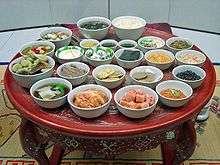Hangwa
| Hangwa | |
.jpg) Various types of hangwa | |
| Korean name | |
|---|---|
| Hangul | 한과, 조과 |
| Hanja | commonly 韓菓, rarely 漢菓 (see #Name section), or 造果 |
| Revised Romanization | hangwa, jogwa |
| McCune–Reischauer | han'gwa, chogwa |
 |
| This article is part of a series on |
| Korean cuisine 한국 요리 조선 료리 |
|---|
|
Staples |
|
|
Hangwa is a general term for Korean traditional confectionery. Common ingredients in hangwa are grain flour, honey, yeot, sugar, fruit or edible root.
Types of hangwa
- Yumilgwa (유과): made by frying and kneading.
- Yakgwa, literally "medicinal confectionery" is a flower shape biscuit made of honey, sesame oil and wheat flour.
- Suksilgwa (숙실과), made by boiling fruits, ginger, or nuts in water and then reformed into the original fruit's shape, or other shapes.
- Gwapyeon (과편), jelly-like confection made by boiling sour fruits, starch, and sugar.
- Dasik (다식), literally "tea snack." It is made by kneading rice flour, honey, and various types of flour from nuts, herbs, sesame, or jujube.
- Yeot (엿): a Korean traditional candy in liquid or solid form made from steamed normal rice, glutinous rice, glutinous kaoliang, corn, sweet potatoes or mixed grains. The steamed ingredients are lightly fermented and boiled in a large pot called sot (솥) for a long time.
- Yeot gangjeong (엿강정) : Pine nuts, peanuts, popped rice, walnuts, roasted beans or sesame seeds rolled in yeot mixture
- Jeonggwa (정과) : Sugarized fruit, ginger, lotus root, carrot or ginseng
- Mandugwa (만두과) : stuffed with a sweetened filling and coated with jocheong, or liquid candy.
History
The history of hangwa goes back to the era of the three kingdoms (BC 57 - AD 688) when it was consumed at the royal court. During the Goryeo dynasty (936–1392) buddhist diets forbade meat, therefore the cultivation of crops spread and increased. Different types of hangwa developed and people were so fond of them officials were afraid it might affect the crop volumes. Hangwa was forbidden by decree twice (in 1179 and 1192) and officials encouraged people to eat fruits instead. Hangwa restrictions continued in the Joseon period, it could only be consumed during ancestral rites, otherwise was punished by monetary fines or beating.[1]
Hangwa had different shapes at first, mimicking living beings, shaped by wooden molds. Some of the shapes had meaning, for example butterflies symbolized happy marriage, lotus stood for harmony and bats brought luck. Later on they were shaped into a ball but this was found to be inconvenient for ancestral rites and eventually became cube-like. Hangwa shapes now include balls, cubes, long tubes, the round ones are printed with various patterns.[1]
Etymology
The word has two components: han and gwa. Gwa means “confectionery”. Han can either mean “Korean” and whose hanja is 韓 or the one that means “Chinese” and whose hanja is 漢. Most sources, such as several major commercial online dictionaries and encyclopedias, define hangwa as “韓菓” (“Korean confectionery”), counterpart of yanggwa (洋果), Western confectionery.[2][3] According to the Internet edition of a standard dictionary by the National Institute of the Korean Language, South Korea's official language regulating body, has “漢菓” (literally “Chinese confectionery”) with an explanation, calling it a kind of yumilgwa, which is also variety of Korean confectionery.[4][5]
See also
- Confectionery
- List of Korean desserts
-
 Food portal
Food portal
References
- 1 2 "Art and history of 'hangwa'". The Korea Times. 2012-01-19. Retrieved 2013-04-16.
- ↑ 韓菓類 (in Korean). Doosan Encyclopedia.
- ↑ 과자 (菓子) (in Korean). Empas / EncyKorea.
- ↑ 한과02 (漢菓). Pyojun gugeo daesajeon (표준 국어 대사전) (in Korean). National Institute of the Korean Language. Retrieved 2009-02-27.
- ↑ "Entries for '한과'". Pyojun gugeo daesajeon (표준 국어 대사전) (in Korean). National Institute of the Korean Language. Retrieved 2009-02-27.
External links
| Wikimedia Commons has media related to Hangwa. |
- General information about Korean desserts
- (Korean) Information about Hangwa
- (Korean) Information about Hangwa
- (Korean) Information about Bonghwa daksil hangwa maeul and Hangwa